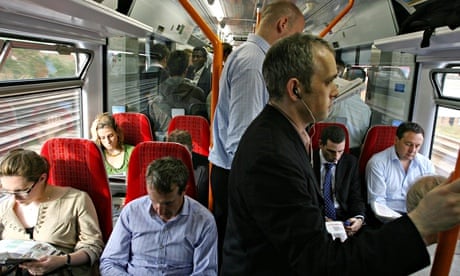The 7.32 from Woking to Waterloo is thought to be Britain's most crowded commuter train service, with nearly seven people for every four seats, figures released by the Department for Transport on Wednesday reveal.
The DfT snapshot recorded 1,278 passengers arriving in London in the morning rush hour on a South West Trains service designed for 738 people.
Research conducted in spring and autumn 2013 showed that a London Midland service leaving the capital for Crewe was even more crowded, but the number of carriages was doubled after the study was conducted.
The 10 most congested trains identified in late 2013 included three morning services to London Paddington on First Great Western and two TransPennine Express trains running in opposite directions between Manchester airport and the north-east.
The broader figures showed 545,000 passengers arriving in London at the morning peak, with one in five having to stand. Paddington was the worst-affected station in the capital for crowded services. Sheffield, Manchester, Leeds and Liverpool all reported services where passengers had to stand for more than 20 minutes at peak times. Sheffield had the worst overcrowding outside London.
Claire Perry, the transport minister, said train operators needed to tackle crowding. "Since 1995, passenger journeys on the railway have more than doubled, with 1.6bn journeys being recorded in the last year," she said.
"This means that on too many journeys passengers have to stand in cramped conditions. Train operators must act now; they must find new ways to create space on the network and in their trains.
"I understand the frustration of rail passengers forced to stand on busy services and that is why I am calling on the operators to do more."
The DfT said the level of overall crowding had stayed much the same as the previous year, but had worsened in some cities. It added that the top 10 list of crowded trains was a snapshot of train overcrowding rather than definitive, and that crowded rural and regional services had not been included in its count.
The Rail Delivery Group, which represents Network Rail and rail operators, said there were 1.5m more passenger services running than there were 15 years ago, which had made Britain's railway into Europe's fastest-growing network. "While the official measure of crowding during peak times now compared with then has remained largely unchanged despite a doubling in passenger journeys," it said, "we recognise that some services remain crowded and understand people's frustration when they cannot get a seat.
"Because rail users are at the heart of what we do, the industry is already planning to increase peak-time seats into and out of many major cities by a third in the next five years."
Mary Creagh, the shadow transport secretary, said it was "a far cry from the 'comfortable commuting' which ministers imagine on the railway". She added: "This misery map shows the reality of life for commuters in David Cameron's Britain. In the north, TransPennine Express passengers will lose 18 carriages in spring 2015, adding to the problems of Manchester commuters."
James MacColl, of the Campaign for Better Transport, said: "With up to one in five passengers to have to stand having to stand and ticket prices increasing much faster than wages, rail commuters will be questioning the value for money they get. The government needs to continue investing in the railways with a long-term strategy to cope with demand and keep fares affordable."
The 10 worst offenders
(figures from autumn 2013)
1. 16:46 London Midland train from London Euston to Crewe
2. 07:32 South West Trains service from Woking to London Waterloo
3. 07:21 First Great Western train from Oxford to London Paddington
4. 18:33 Heathrow Connect train from London Paddington to Heathrow
5. 06:30 First TransPennine Express from Manchester airport to Middlesbrough
6. 18:13 London Midland train from London Euston to Birmingham New Street
7. 06:07 First Great Western train from Banbury to London Paddington
8. 06:30 First TransPennine Express from Scarborough to Manchester airport
9. 06:28 East Midlands train from Nottingham to St Pancras
10. 07:00 First Great Western train from Oxford to London Paddington
(figures from autumn 2013)

Comments (…)
Sign in or create your Guardian account to join the discussion